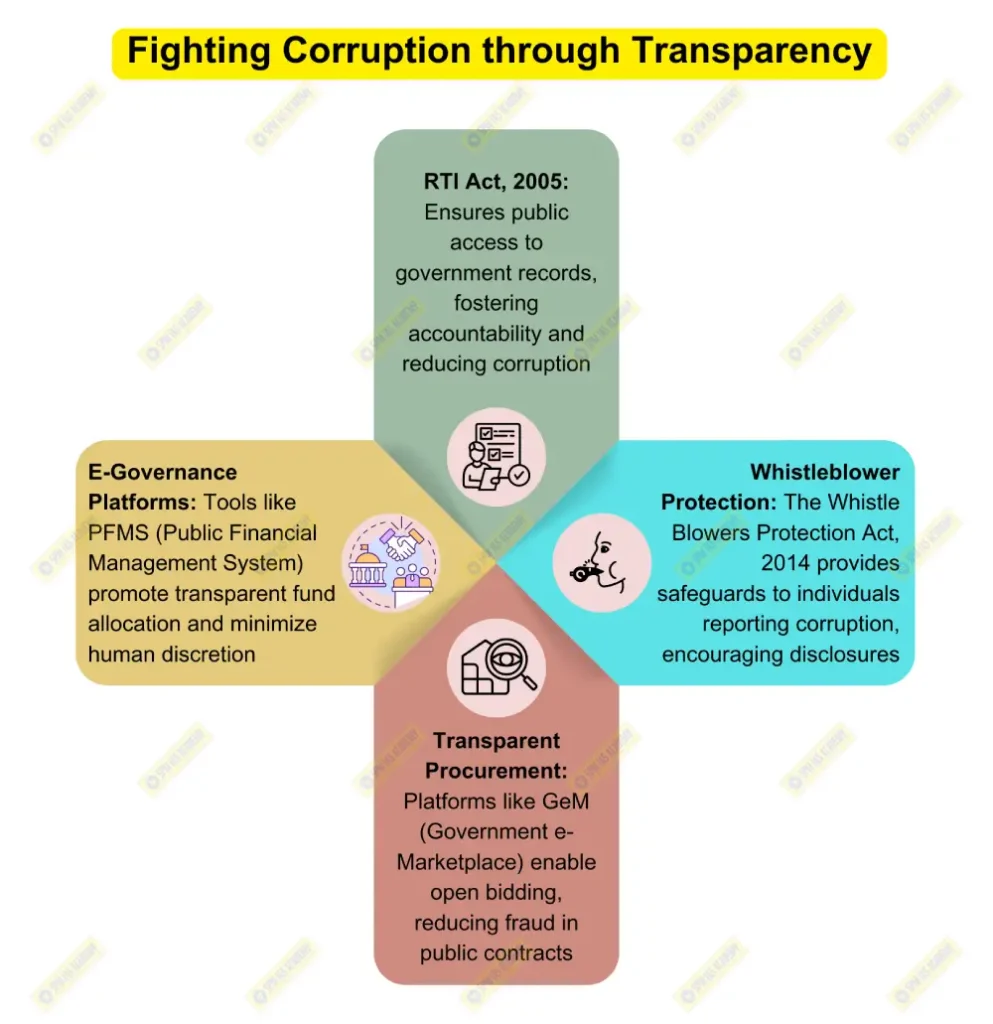Transparency in governance is a cornerstone of ethical governance, ensuring accountability, citizen empowerment, and trust in public institutions. Over the years, the Indian government has implemented several measures to enhance transparency and curb corruption, addressing the principles of integrity, probity, and public interest. These initiatives leverage technology, legislation, and institutional reforms to promote openness and reduce opportunities for corrupt practices.
Principal Measures to Enhance Transparency

- Right to Information Act (RTI), 2005
○ RTI empowers citizens to seek information from public authorities, fostering accountability and reducing the misuse of power.
○ Example: RTI has exposed high-profile scams, such as the Adarsh Housing Society scam, leading to greater vigilance in public administration. - Lokpal and Lokayuktas Act, 2013
○ Establishes an independent ombudsman to investigate corruption complaints against public officials, including ministers.
○ Impact: While implementation remains uneven, the Lokpal has acted as a deterrent for high-level corruption. - Direct Benefit Transfer (DBT)
○ DBT eliminates intermediaries by directly transferring subsidies to beneficiaries’ accounts, ensuring efficiency and transparency.
○ Example: The scheme saved ₹2.23 lakh crore by reducing leakages in programs like PM Kisan and LPG subsidies. - Government e-Marketplace (GeM), 2016
○ GeM promotes transparency in procurement by digitizing government purchases, minimizing corruption in tenders and contracts.
○ Example: As of 2023, GeM facilitated transactions worth ₹3.9 lakh crore, reducing collusion and favoritism in procurement. - IT-Based Initiatives
○ Digital Governance: Platforms like e-Procurement, PRAGATI, and MyGov ensure real-time monitoring and citizen engagement.
○ Anti-Corruption Apps: Tools like Vigilance App enable whistleblowers to report corruption anonymously, enhancing ethical oversight.
○ Example: Aadhaar integration in welfare schemes eliminated 4.4 crore fake ration cards, reducing corruption in the PDS system. - Prevention of Corruption (Amendment) Act, 2018
○ Strengthened legal provisions by criminalizing the giving of bribes and mandating prior approval for prosecuting public servants, ensuring probity.
Has Transparency Reduced Corruption?
- Positive Impact
○ Efficiency and Trust: Initiatives like DBT and Aadhaar-linked systems have drastically reduced leakages and fostered trust in welfare programs.
○ Example: The JAM Trinity (Jan Dhan-Aadhaar-Mobile) significantly reduced graft in disbursing subsidies.
○ E-Governance Success: Digitization of services has reduced discretionary powers, limiting opportunities for bribery. For instance, passport issuance timelines have been cut to a few days with minimal human intervention. - Challenges Persist
○ Institutional Weaknesses: Delayed implementation of Lokpal and limited powers of Lokayuktas in some states weaken anti-corruption frameworks.
○ Cultural Resistance: Corruption remains entrenched in certain sectors, such as real estate and police, where informal practices persist despite digital reforms.
○ Lack of Awareness: RTI, though powerful, is underutilized due to low public awareness, particularly in rural areas.
While government measures like RTI, DBT, GeM, and anti-corruption laws have significantly improved transparency and curbed corruption, challenges remain in ensuring their universal application and acceptance. As Kautilya observed in the Arthashastra, “Just as it is impossible not to taste honey that is placed on the tongue, so it is impossible for a government servant not to taste public funds.” Sustained efforts in ethical leadership, public participation, and systemic reforms are crucial to building a transparent and corruption-free governance framework.











